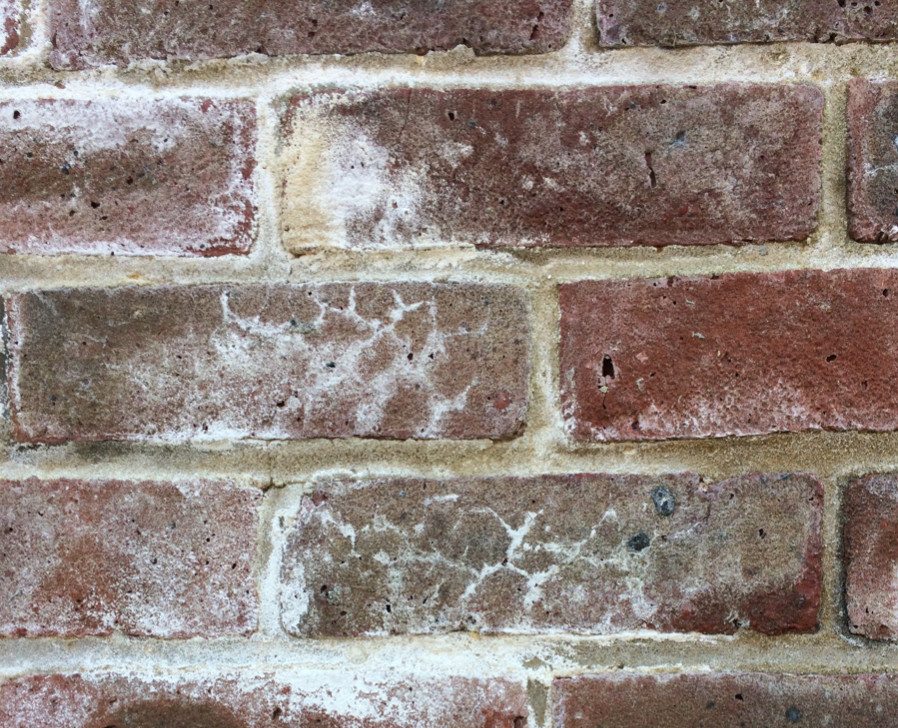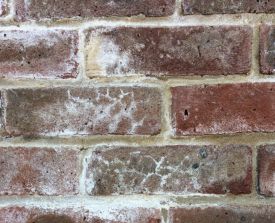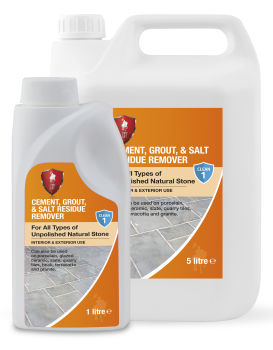
Efflorescence is unsightly and can be difficult to remove. It’s common on brick walls, where it leaves a white, power-like stain or ‘bloom’ on surfaces. It can also rise through grout joints and affect tile installations and patios.
 More of a process than a reaction, efflorescence is made up of soluble salts and moisture that rise, evaporate and leave a crystalline salt deposit behind. It can occur after exposure to moist or cool conditions, or more gradually, and it’s often a seasonable problem. Standard cleaning products won’t effectively remove it and brick acid – a traditional acid cleaner – is often recommended by the building trade as a go-to solution. There are many reasons why this shouldn’t be used. Brick acid is hazardous and corrosive. It often has a hydrochloric base which effectively strips a surface of its top layer. It’s especially damaging to acid-sensitive materials, like limestone, where it effectively eats away at the surface.
More of a process than a reaction, efflorescence is made up of soluble salts and moisture that rise, evaporate and leave a crystalline salt deposit behind. It can occur after exposure to moist or cool conditions, or more gradually, and it’s often a seasonable problem. Standard cleaning products won’t effectively remove it and brick acid – a traditional acid cleaner – is often recommended by the building trade as a go-to solution. There are many reasons why this shouldn’t be used. Brick acid is hazardous and corrosive. It often has a hydrochloric base which effectively strips a surface of its top layer. It’s especially damaging to acid-sensitive materials, like limestone, where it effectively eats away at the surface.
To allow safe, effective removal, LTP has developed a Cement, Grout & Salt Residue Remover which has a synthetic base. The acid-replacement treatment can be used on all types of tile and natural stone surfaces, except those with a polished finish. This means that it can be safely applied to unpolished acid-sensitive surfaces, including limestone and travertine, as well as all types of masonry. It can also be used on porcelain, glazed ceramics, quarry tiles and terracotta, slate, sandstone, granite and unpolished natural stone – indoors and outside. The treatment also removes rising salt caused by substrate moisture and spot fixing – as well as cement and grout residues.
 When using cleaning chemicals, always wear protective gloves, clothing and eye protection. Before treating a large area, always carry out a test on a small, inconspicuous area. To see how the treatment is applied, watch the video aid and carefully follow the application instructions. There’s also more information on the LTP Technical Data Sheet.
When using cleaning chemicals, always wear protective gloves, clothing and eye protection. Before treating a large area, always carry out a test on a small, inconspicuous area. To see how the treatment is applied, watch the video aid and carefully follow the application instructions. There’s also more information on the LTP Technical Data Sheet.
To remove mild staining and to treat non-absorbent surfaces dilute 1 part of the Remover with 4 parts of cool water. Always dilute the treatment by adding it to water, rather than the other way around. Apply with a cloth or sponge wrung out in the solution. Leave to act for up to 30 minutes. Wipe away the released surface residue with a sponge and cool, clean water.
For more severe staining, use a 1:1 dilution and, if necessary, agitate the surface with a scrubbing brush. Leave to act for 5-10 minutes, keeping the surface wet with additional Remover. Wipe away the residue and rinse, as before.
In extreme cases, the Remover can also be applied neat and the surface agitated with a nylon pad, scrubbing brush or mechanical scrubber. Residues should then be removed straight away and the surface rinsed immediately.
All LTP treatments are made and stocked in the UK. To shop and find out more, visit http://www.ltp-online.co.uk. For further information, contact LTP on tel. 01823 666213 or email [email protected]



